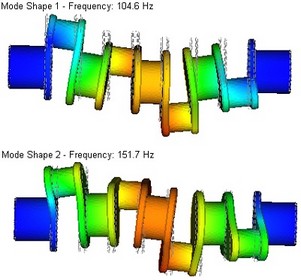 |
AutoFEM Analysis Frequency Analysis | ||||||
The goal of Frequency Analysis
The frequency analysis module serves for calculating natural frequencies (resonant frequencies) of a structure's vibrations and the respective vibration patterns. The task of calculating natural frequencies and the respective vibration patterns arises in many practical cases of analysing a structure's dynamical response under varying loads. A most widespread situation is when it is necessary to assure at the design stage a low possibility of the mechanical phenomenon of the resonance under operating conditions. As known, the essence of the resonance is a significant increase in the magnitude of induced vibrations (by dozens of times and even more) at certain frequencies of an external disturbance – the so-called resonant frequencies. In most cases, the occurrence of resonance is an unwanted phenomenon from a product's safety viewpoint. Probing a structure's natural properties against the possibility of a resonance in the operating range of external exciting frequencies at the design stage helps introducing changes in the structure that can alter the natural frequencies spectrum. This could help avoid or significantly lower the possibility of resonance during operation. Thus, the vibro-stability condition with respect to the natural frequencies criterion can be formulated as follows:
A structure's natural frequencies must fall outside the external exciting frequency range: ![]()
where fi - the i-th natural frequency of the structure. Usually, the greatest danger is presented by resonance at lower natural frequencies (![]() ), since that is where the most mechanical energy is concentrated;
), since that is where the most mechanical energy is concentrated;
![]() – the lowest and the highest frequencies of the known range of external exciting vibration.
– the lowest and the highest frequencies of the known range of external exciting vibration.

Variation in the amplitude magnification factor with respect to the natural frequency
to the external exciting frequency ratio in a system with an insufficient damping
By having evaluated natural frequencies of a structure's vibrations at the design stage, you can optimize the structure with the goal of meeting the frequency vibro-stability condition. To increase natural frequencies, you would need to add rigidity to the structure and (or) reduce its weight. For example, in the case of a slender object, the rigidity can be increased by reducing the length and increasing the thickness of the object. To reduce a part's natural frequency, you should, on the contrary, increase the weight or reduce the object's rigidity.


Thus, by calculating resonant frequencies at the design stage using the frequency analysis module and optimizing the part's mass-rigidity properties, the user can raise reliability of the structure being developed from the viewpoint of its vibro-stability and vibrational strength.
See also: Frequency Analysis Steps Settings of Frequency Solver